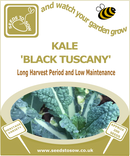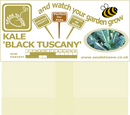Description
Kale 'Nero di Toscana' is an Italian heritage variety with distinct smoky green-black, savoy type leaves which look like a crown of feathers in full maturity. It has a great peppery flavour and can be eaten raw, when young, in salads or when mature, cooked in a variety of ways, with the flavour sweetening once exposed to frost.
It is very hardy and low maintenance and can be harvested over a long period from early summer right through until early spring. A great addition to your garden, either grown in a pot or container or in a vegetable bed.
| When to sow | February to April indoors or in a greenhouse, May to July outdoors. |
| Where to Sow | Kale prefers an open, sunny site with well-drained soil. |
| Sow seed indoors (at 10-15°C/50-60°F) in moist compost filled trays or modules, 1.5cm (3/4in) deep, with 2 seeds per module. | |
| Sow seed direct, thinly, in a prepared bed or in a pot or container, 1.5cm (3/4in) deep in rows 45cm (18in) apart. | |
| What to do Next | For seed sown indoors, as soon as they have their first pair of leaves, prick out into individual pots. Harden off indoor sown seedlings for 7 days prior to planting out when they are about 15cm (6in) tall. Plant out 45cm (18in) apart with rows 45cm (18in) apart. |
| For seeds sown outdoors, thin out seedlings to 45cm (18in) apart once they are large enough to handle. | |
| Water well, especially during periods of dry weather, and keep weed free. | |
| Occasional liquid feed beneficial to encourage continuous healthy growth. | |
| Harvest | June to March, 3 months after sowing. |
| Handy Tips | When transplanting kale, plant it slightly deeper in the ground than it was in the seedbed. Kale is exceptionally hardy and requires little aftercare. |
| Remove yellowing or rotting leaves which may appear round the base. | |
| Earth up at the end of autumn to help protect against frost and wind. | |
| Frost will help to sweeten the taste and also encourage the leaves to wrinkle and curl, creating a more satisfying textural leaf. | |
| Companion Planting | Good Companions: Beets, Celery, Cucumbers, Dill, Garlic, Lettuce, Mint, Nasturtium, Onions, Potatoes, Rosemary, Sage, Spinach, Swiss chard. |
| Bad Companions: Strawberry, tomato, beans, mustards, basil. | |
| Nutritional Information | Pro-vitamin A, vitamin C, iron & folic acid, and calcium. |
| Serving Suggestion | Kale can be steamed, boiled, stir fried or added to soups and stews. Kale also goes well shredded raw in salads. Used extensively in Italian cooking, it goes well with Pork, Lamb, mushrooms and Garlic. |
Payment & Security
Your payment information is processed securely. We do not store credit card details nor have access to your credit card information.




